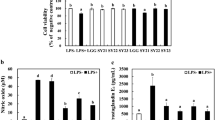Abstract
Lactobacillus plantarum is a well-documented probiotic that has been used in clinical trials for the regulation of the immune system and treatment of gastrointestinal diseases. In this study, we evaluated the effects of L. plantarum cell lysates on the immune regulation through the in vitro and in vivo studies. L. plantarum lysates were prepared by sonication method, and we observed that the repetition of disruption step increased indicator components within the bacterial lysates. Indicator components might affect TNF-α production. L. plantarum lysates did not induce TNF-α production, while LPS-induced TNF-α production was dramatically inhibited in a sonication-dependent manner in THP-1 cells. Oral administration of L. plantarum lysates effectively attenuated the horny layer formation and decreased epidermal thickening in NC/Nga mice skin. The damage to barrier function after the 8 weeks oral administration was reduced by L. plantarum lysates as compared to that in the atopic dermatitis (AD) mice. Further study revealed that L. plantarum lysates polarized Th1 response via induction of IL-12 and IFN-γ production and inhibition of IL-4 and IgE production in NC/Nga mice. Together, our results suggest that L. plantarum lysates are remarkable material for host homeostasis and it could be used for the treatment of inflammatory diseases.
Similar content being viewed by others
References
Barel, A.O. and Clarys, P. 1995. Study of the stratum corneum barrier function by transepidermal water loss measurements: comparison between two commercial instruments: Evaporimeter and Tewameter. Skin Pharmacol. 8, 186–195.
Bowman, L.M. and Holt, P.G. 2001. Selective enhancement of systemic Th1 immunity in immunologically immature rats with an orally administered bacterial extract. Infect. Immun. 69, 3719–3727.
Chan, L.S. 2008. Atopic dermatitis in 2008. Curr. Dir. Autoimmun. 10, 76–118.
Cooper, K.D. 1994. Atopic dermatitis: recent trends in pathogenesis and therapy. J. Invest. Dermatol. 102, 128–137.
Draing, C., Pfitzenmaier, M., Zummo, S., Mancuso, G., Geyer, A., Hartung, T., and von Aulock, S. 2006. Comparison of lipoteichoic acid from different serotypes of Streptococcus pneumoniae. J. Biol. Chem. 281, 33849–33859.
Elliott, G.R., Vanwersch, R.A., and Bruijnzeel, P.L. 2000. An automated method for registering and quantifying scratching activity in mice: use for drug evaluation. J. Pharmacol. Toxicol. Methods 44, 453–459.
Georgieva, R.N., Iliev, I.N., Chipeva, V.A., Dimitonova, S.P., Samelis, J., and Danova, S.T. 2008. Identification and in vitro characterisation of Lactobacillus plantarum strains from artisanal Bulgarian white brined cheeses. J. Basic Microbiol. 48, 234–244.
Meydani, S.N. and Ha, W.K. 2000. Immunologic effects of yogurt. Am. J. Clin. Nutr. 71, 861–872.
Morath, S., Geyer, A., and Hartung, T. 2001. Structure-function relationship of cytokine induction by lipoteichoic acid from Staphylococcus aureus. J. Exp. Med. 193, 393–397.
Ozdemir, O. 2010. Various effects of different probiotic strains in allergic disorders: an update from laboratory and clinical data. Clin. Exp. Immunol. 160, 295–304.
Pfefferle, P.I., Prescott, S.L., and Kopp, M. 2013. Microbial influence on tolerance and opportunities for intervention with prebiotics/probiotics and bacterial lysates. J. Allergy Clin. Immunol. 131, 1453–1463.
Philpott, D.J., Sorbara, M.T., Robertson, S.J., Croitoru, K., and Girardin, S.E. 2014. NOD proteins: regulators of inflammation in health and disease. Nat. Rev. Immunol. 14, 9–23.
Rosenthal, R.S. and Dziarski, R. 1994. Isolation of peptidoglycan and soluble peptidoglycan fragments. Methods Enzymol. 235, 253–285.
Saijic, D., Asiniwasis, R., and Skotnicki-Grant, S. 2012. A look at epidermal barrier function in atopic dermatitis: Physiologic lipid replacement and the role of ceramide. Skin Therapy Lett. 7, 6–9.
Sato, Y., Akiyama, H., Suganuma, H., Watanabe, T., Nagaoka, M.H., Inakuma, T., Goda, Y., and Maitani, T. 2004. The feeding of beta-carotene down-regulates serum IgE levels and inhibits the type I allergic response in mice. Biol. Pharm. Bull. 27, 978–984.
Schultz, M., Veltkamp, C., Dieleman, L.A., Grenther, W.B., Wyrick, P.B., Wyrick, P.B., Tonkonogy, S.L., and Sartor, R.B. 2002. Lactobacillus plantarum 299V in the treatment and prevention of spontaneous colitis in interleukin-10-deficient mice. Inflamm. Bowel Dis. 8, 71-80.
Seo, H.S., Cartee, R.T., Pritchard, D.G., and Nahm, M.H. 2008. A new model of pneumococcal lipoteichoic acid structure resolves biochemical, biosynthetic, and serologic inconsistencies of the current model. J. Bacteriol. 190, 2379–2387.
Snapper, C.M. and Paul, W.E. 1987. Interferon-gamma and B cell stimulatory factor-1 reciprocally regulate Ig isotype production. Science 236, 944–947.
Van Bever, H.P. 1992. Recent advances in the pathogenesis of atopic dermatitis. Eur. J. Pediatr. 151, 870–873.
Varothai, S., Nitayavardhana, S., and Kulthanan, K. 2013. Moisturizers for patients with atopic dermatitis. Asian Pac. J. Allergy Immunol. 31, 91–98.
Volz, T., Skabytska, Y., Guenova, E., Chen, K.M., Frick, J.S., Kirschning, C.J., Kaesler, S., Röcken, M., and Biedermann, T. 2014. Nonpathogenic bacteria alleviating atopic dermatitis inflammation induce IL-10-producing dendritic cells and regulatory Tr1 cells. J. Invest. Dermatol. 134, 96–104.
Wallace, T.C., Guarner, F., Madsen, K., Cabana, M.D., Gibson, G., Hentges, E., and Sanders, M.E. 2011. Human gut microbiota and its relationship to health and disease. Nutr. Rev. 69, 392–403.
Xie, N., Cui, Y., Yin, Y.N., Zhao, X., Yang, J.W., Wang, Z.G., Fu, N., Tang, Y., Wang, X.H., Liu, X.W., and et al. 2011. Effects of two Lactobacillus strains on lipid metabolism and intestinal microflora in rats fed a high-cholesterol diet. BMC Complement Altern. Med. 11, 53.
Author information
Authors and Affiliations
Corresponding author
Rights and permissions
About this article
Cite this article
Kim, H., Kim, H.R., Kim, NR. et al. Oral administration of Lactobacillus plantarum lysates attenuates the development of atopic dermatitis lesions in mouse models. J Microbiol. 53, 47–52 (2015). https://doi.org/10.1007/s12275-015-4483-z
Received:
Revised:
Accepted:
Published:
Issue Date:
DOI: https://doi.org/10.1007/s12275-015-4483-z




